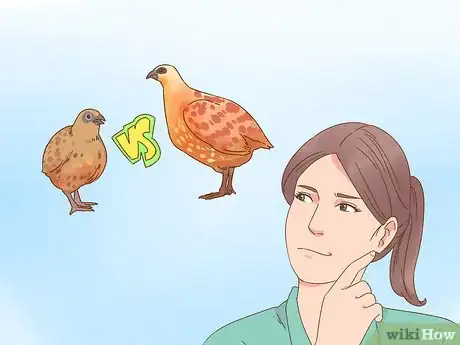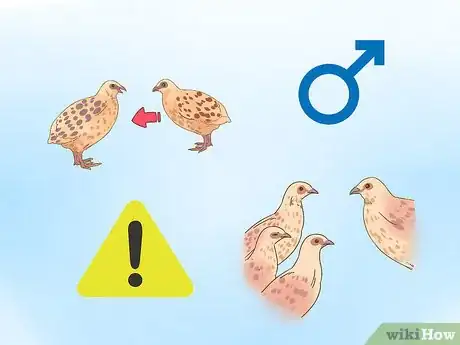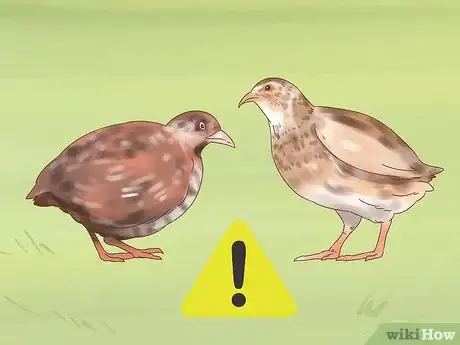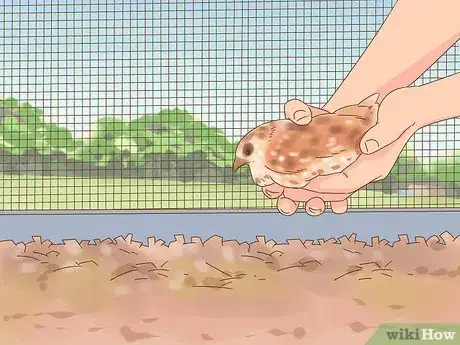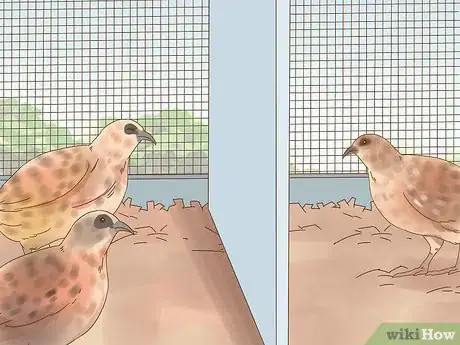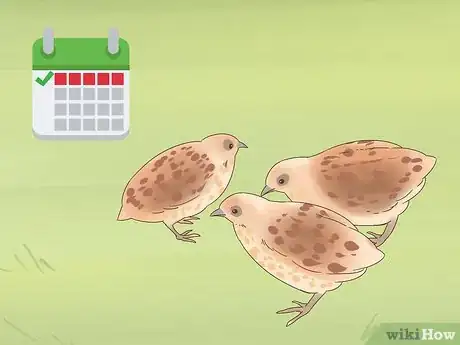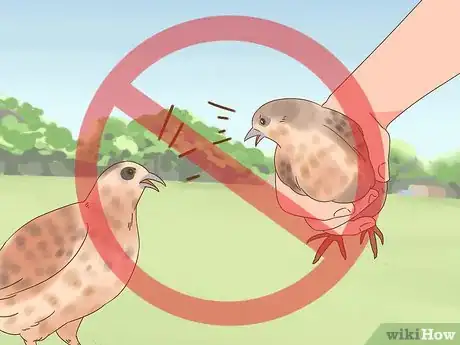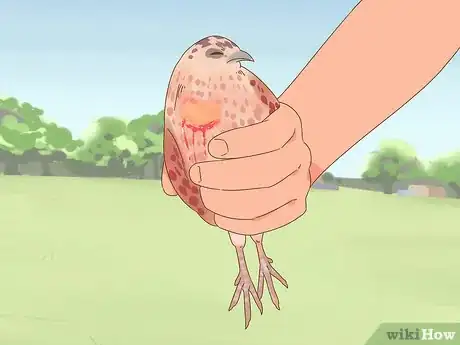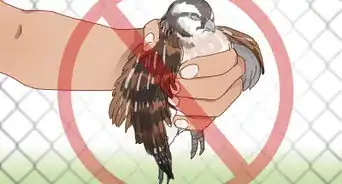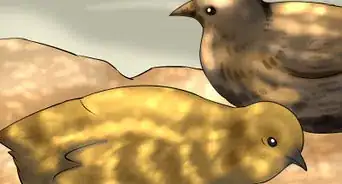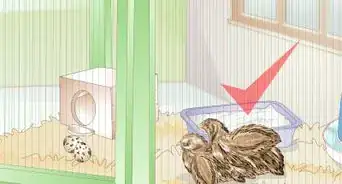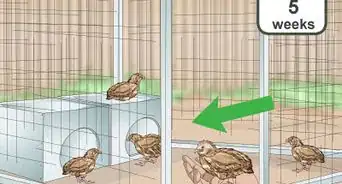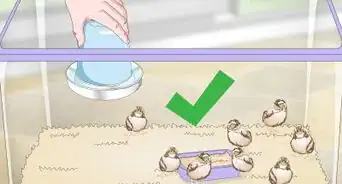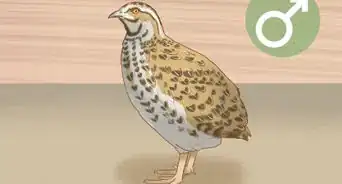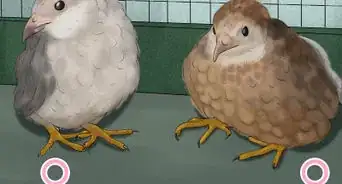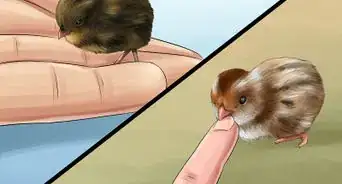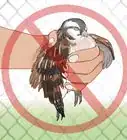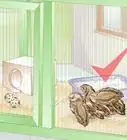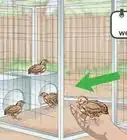This article was co-authored by Amy Harrison, a trusted member of wikiHow's volunteer community. Amy Harrison has over five years of experience working directly with poultry. She has worked on a rural chicken farm built around marketing free-range eggs, where she managed the care for the poultry year-round. She has experience breeding chickens and quail, caring for newborn poultry, handling their health issues, and managing their dietary needs.
This article has been viewed 23,672 times.
Learn more...
Quails are very territorial birds that often do not get along well with newbies. However, with the right practices in mind, new birds can be integrated seamlessly into an existing flock. This article will explain how to expand your flock while minimizing potential animus between the newer and older birds.
Steps
Meeting the Housing Requirements
-
1Make sure you have enough space. Before even considering adding a new batch of quails to your flock, you must ensure that there is enough space to house them together happily. The rule of thumb is 1 square foot per bird; however, it is advised to go bigger especially if you are transitioning new birds to the flock.
- Quails hold a sense of territory, so giving more space to your birds will help them accept new quails. In the event that an established quail attacks a new quail, that quail should have enough space to run away.
-
2Add hiding spots. Along with providing plenty of space, the new quails will need a few spots to hide when they get chased or attack by the original flock (which will normally happen).Advertisement
-
3Count the feeding, drinking and nesting stations available. Once you exceed a certain number it becomes time to add more items to the pen to meet your quails required needs.
- If you are housing over 30 birds then you may need to double the amount of feeders, drinkers and nesting boxes you have so that there no fights break out over who can get to the food bowl first.
- Use large guinea pig igloos/huts for an undercover area. You should add at least two.
-
4Set a divider in the cage. You can separate a quarter or half of a section of the pen if you feel like you are required to do so. This is an effective setting scene as the quail can all see each other and communicate, but cannot peck or attack each other.
Choosing Your Quail
-
1Ask yourself why you want new birds. Is it for eggs, meat, breeding or a mix of both? Perhaps you simply want more pets? With quail it is important to know what a flock should consist of to avoid complications.
-
2Be aware of the age gap. If there is too much of an age gap between your newer and older quails, they will start fighting each other and never transition. Younger quails against an adult flock will never stand a chance.
- If you have an adult flock then you must purchase quails that are over 6 months of age, which by then will be matured birds and laying eggs.
- If you have a flock of juvenile quail then purchase more juvenile birds rather than adults and vice versa.
- If you want more eggs then it is advised to buy young hens of 6 months of age. This is when they start laying.
- If it's meat you want then some breeders say to start with a lot of young chicks and raise them yourself to save money. However, buying adult birds ready for slaughter in a few weeks is always an option.
- For breeding, you should always start with young matured birds. For every 3-5 hens you should have one roo.
-
3Understand the importance of gender ratios. Most males are very territorial and dominant. Some will never accept another male into their flock. If you have enough hens in your flock it is possible for you to try and introduce another male, but if it doesn't work out you may need an escape plan.
-
4Consider the breed. Despite all being the same species, you cannot mix other breeds with a different kind. E.g button quail cannot be mixed with Coturnix quail.
Transitioning the Quail
-
1Quarantine the new birds. Foreign quails from another flock can have the possibility of carrying diseases, and if they bring it into your new flock, all the birds will get sick. To take extra precautions it is advised to quarantine new birds for 6-8 weeks before mixing them with your flock.
-
2Consider introducing the quail in a new space. There are mixed opinions on if you introduce the flock together in a completely new area then the transitioning will run more smoothly. This is said to work because quails are territorial over their home, and if they are all introduced to new surroundings then there is one less thing to fight over.
-
3Set up a border in the pen. Use up quarter or half of the space to separate the new quails from the current flock. The border should allow the quails to see each other whilst making sure they don't attack each other.
-
4Remove the border after a week or two. After the waiting period with the border set in place it should be time to take away the border and transition the quail together.
-
5Supervise the quail. Immediately after taking away the border it is important to continue supervising the quail. The remainder flock should start gaining curiosity of the new flock. Of course this can always lead to fights breaking out so you need to be there just in case that happens.
-
6Avoid intervening. If pecking and fighting does occur between the flock, avoid getting involved. This is natural behavior to show dominance and establish a pecking order. If blood draw then that's when you need to get involved and remove the wounded quail immediately.
-
7Separate the birds if blood is drawn. Just like day-old chicks, the quail will only keep pecking at a bloody wound. It is instinct to kill the weakest bird of the flock, especially if injured. Quarantine the quail until the wound fully heals and try introducing them again.
Community Q&A
-
QuestionWhat do I do if my button quail attempt to kill each other?
 Community AnswerSeparate the bully. I would recommend locking the naughty bird in a dark room with food and water. This will reset the pecking order.
Community AnswerSeparate the bully. I would recommend locking the naughty bird in a dark room with food and water. This will reset the pecking order. -
QuestionWill young quails (6-8 weeks) fight with each other if they haven’t met each other before?
 Amy HarrisonTop AnswererWhile quail are territorial in nature, it's unlikely they will seriously hurt each other if they are given plenty of space, food, and hides. Of course, they will squabble and establish dominance in order to create a pecking order, but this is normal.
Amy HarrisonTop AnswererWhile quail are territorial in nature, it's unlikely they will seriously hurt each other if they are given plenty of space, food, and hides. Of course, they will squabble and establish dominance in order to create a pecking order, but this is normal.
Warnings
- If blood is drawn it's important to get the injured quail separated from the rest of the flock.⧼thumbs_response⧽
__





